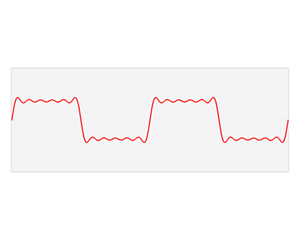Wikipedia:Featured picture candidates/Fourier transform time and frequency domains
Appearance
Voting period is over. Please don't add any new votes. Voting period ends on 13 Mar 2013 at 22:52:29 (UTC)

- Reason
- high quality, well paced and comprehensive animation illustrating a wave can be constructed from a series of sine waves, which is what a fourier transform is. Essentially it's an animation of a fourier transform.
- Articles in which this image appears
- Fourier transform, Fourier series, Frequency domain, Time domain
- FP category for this image
- sciences, mathematics
- Creator
- LucasVB
- Support as nominator --JohnBlackburnewordsdeeds 22:52, 4 March 2013 (UTC)
- Comment (1) Shouldn't the higher resolution file be the one for FP, even if it isn't used directly in the article due to thumbnail problems? (2) I think the way the red and blue graphs are shown vertically stacked at the end is confusing. Their horizontal axes are completely different dimensions, but stacking them like that invites the viewer to think they correspond to each other. --Paul_012 (talk) 08:37, 5 March 2013 (UTC)
- They correspond to each other accurately. The issue is that I just decided to evenly space them across the time domain window, instead of placing them in the accurate x coordinate, otherwise they would be too close together and there would be a large gap to the right. Adding more components would only worsen the situation. — LucasVB | Talk 15:46, 5 March 2013 (UTC)
- Oppose This graph purportedly shows the Fourier transform of . Whilst it might usefully demonstrate some concepts, like the frequency domain, it is flat out wrong as the Fourier transform of . Firstly, Fourier transform of a sine wave is a purely imaginary valued distribution. The graph might have been OK if it was clear that only the magnitude of the transform was shown, but the Fourier transform of the sine function is also symmetric about the origin. So in some sense, only half the story is there. There are minor issues for Fourier series too, but that is closer to where this image belongs. JJ Harrison (talk) 08:40, 5 March 2013 (UTC)
- The image was intended to illustrate time and frequency domains, and what each one represents for a function. I agree that the image does belong better in Fourier series, for the reasons you stated. I've attempted to capture the transform in another animation (shown below). Not sure if it's worth including anywhere. It's a hard concept to approach. — LucasVB | Talk 15:46, 5 March 2013 (UTC)
- Oppose — Agree with JJ Harrison. This image has a clever concept, but the image really only has meaning if you already understand Fourier transforms, and if you already understand Fourier transforms, you'd realize that the image leaves out too much that is important. I do a fair amount of scientific illustration on Wikipedia, and I realize that it can be very difficult to walk the line between a completely comprehensible image versus one that is completely accurate. I still agonize over (good? bad?) decisions that I've made in producing images like File:Fabry Perot Interferometer - diagram.png. Although I empathize with the dilemma that the author of the animated image must have faced, I cannot support this image for FP. Stigmatella aurantiaca (talk) 11:24, 5 March 2013 (UTC)
- The point of the image was to illustrate time and frequency domains, not the Fourier transform/series per se. — LucasVB | Talk 15:46, 5 March 2013 (UTC)
- Oppose As the author, I must say I'm aware of the issues and agree with the points made by JJ Harrison and Stigmatella aurantiaca. However, I must point out that the purpose of this animation was to illustrate time and frequency domains, and what a function may look like in both, and what the peaks in the frequency domain represent. It's very tricky if not impossible to illustrate a complex, continuous Fourier transform the way we would wish to do it. A few artistic liberties must be taken in order to make things visually understandable and clear, and all we can do is hope that will path the way for the deeper understanding of the subject. This is what I try to achieve with my animations. In the end, you have to rely on specific examples and explain the caveats. I try not to sacrifice accuracy for style, but sometimes it isn't totally possible, especially if the animation is to be taken on its own merit without an accompanying article or description. — LucasVB | Talk 15:46, 5 March 2013 (UTC)
- I have also made a continuous version, with the time and frequency domains to scale (shown at right). The cosine components end up being not to scale. Using a different function or a different definition of the Fourier transform creates a whole lot of problems on their own regarding vertical and horizontal ranges. — LucasVB | Talk 15:46, 5 March 2013 (UTC)
- I'm glad you understand. I, too, would oppose nomination of almost every one of my own images, were any of them to come up for FP. (Fat chance!!! :-D ) My images are useful and relevant when carefully integrated with the text of an article, but don't have the sorts of merits that would enable them to stand on their own as a Featured Picture. Scientific illustration is tough. Stigmatella aurantiaca (talk) 16:50, 5 March 2013 (UTC)
Not Promoted --Armbrust The Homunculus 23:30, 13 March 2013 (UTC)

